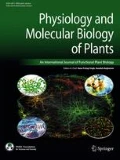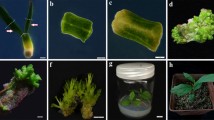Abstract
A rapid, reproducible and efficient regeneration method was developed for chickpea (Cicer arietinum L.) using single cotyledon with half embryonal axis as explants. MS medium supplemented with 4 ìM TDZ, 10 ìM 2-iP and 2 ìM kinetin induced 50–100 adventitious buds/shoots after 14 days of culture and elongated on MS medium supplemented with 5 ìM 2-iP and 2 ìM kinetin. Healthy, strong and 100 % rooting was achieved by exposing cut ends of the shoots to 10 sec pulse treatment with 100 ìmoles/ml IBA followed by their transfer to liquid MS basal medium within 10–14 d. 2–3 cm long shoots were most suitable for rooting. Potting-mixture with good aeration and lesser capacity to retain water was most suitable for achieving successful establishment of chickpea plantlets. Garden soil mixed with sand (gravel) and bio-manure in the ratio of 1:1:1 is most suitable for achieving cent percent transplantation success. Cent percent of plantlets got acclimatized, survived in the pots and showed normal growth, development, flowering followed by podding and seeds setting. Harvesting of seeds was done after the pods were fully matured and dry. In this communication, we have demonstrated for the first time that shoot length, pulse treatment of cut ends of shoots with 100 ìmoles/ml IBA and aeration of potting mixture are key factors for rapid micro-propagation and successful establishment of chickpea.
Similar content being viewed by others
References
Barna KS and Wakhlu AK (1993). Somatic embryogenesis and plant regeneration from callus cultures of chickpea (Cicer arietinum L.). Plant Cell Rep. 12: 521–524
Chakraborti D, Sarkar A and Das S (2006). Efficient and rapid in vitro plant regeneration system for Indian cultivars of chickpea (Cicer arietinum L.). Plant Cell Tiss. Org. Cult. 86: 117–123
Chauhan R and Singh NP (2002). Plant regeneration via somatic embryogenesis in chickpea (Cicer arietinum L.). Ind. J. Genet. 62: 319–321
Chauhan R, Tiwari A and Singh NP (2003). Differential requirement of mature and immature embryo of chickpea (Cicer arietinum L.) for in vitro regeneration. Ind. J. Plant Physiol. 8: 28–33
Chen JT and Chang WC (2006). Direct somatic embryogenesis and plant regeneration from leaf explants of Phalaeopsis amabilis. Biol. Plant. 50: 169–173
Cournac L, Dimon B, Carrier P, Lahou A and Chagvardieff P (1991). Growth and photosynthetic characteristics of Solanum tuberosum plantlets cultivated in vitro in different conditions of aeration, source supply and CO2 enrichment. Plant Physiol. 97: 112–117
Devlin RM, Zbiec II and Nowicka SE (1989). The effect of TDZ on some plant growth systems. Proc. Plant Growth Regul. Soc. 16: 99–103
Ebrahim MKH and Ibrahim AI (2000). Influence of medium solidification and pH value on in vitro propagation of Maranta leuconeura cv Kerchoviana. Sci. Hortic. 86: 211–221
Eisinger W (1983). Regulation of pea internode expansion by ethylene. Ann. Rev. Plant Physiol. 34: 225–240
Ganeshan S, Baga M, Harvey BL, Rossnagel BG, Scoles GJ and Chibbar RN (2003). Production of multiple shoots from thidiazuron-treated mature embryos and leaf-base/apical meristems of barley (Hordeum vulgare). Plant Cell Tiss. Org. Cult. 73: 57–64
Hazarika BN (2006). Morpho-physiological disorders in in vitro culture of plants. Sci. Hortic. 108: 105–120
Huetteman CA and Preece JE (1993). Thidiazuron: a potent cytokinin for woody plant tissue culture. Plant Cell Tiss. Org. Cult. 33: 105–119
Indurker S, Misra HS and Eapen S (2007). Genetic transformation of chickpea (Cicer arietinum L.) with insecticidal crystal protein gene using particle gun bonbardment. Plant Cell Rep. 26: 755–63
Jackson MB, Abbott AJ, Belcher AR, Hall KC, Butler R and Cameron J (1991). Ventilation in plant tissue culture and effects of poor aeration on ethylene and carbon dioxide accumulation, oxygen depletion and explants development. Ann. Bot. 67: 229–237
Jayanand B, Sudarsanam and Sharma KK (2003). An efficient protocol for the regeneration of whole plants of chickpea (Cicer arietinum L.) by using axillary meristem explants derived from in vitro germinated seedlings. In Vitro Cell Dev. Biol. Plant 39: 171–179
Jiang B, Yang Y, Guo Y, Guo Z and Chen Y (2005). Thidiazuron-induced in vitro shoot organogenesis of the medicinal plant Arnebia euchroma (Royle) Johnst. In Vitro Cell Dev. Biol. Plant 41: 677–681
Kar S, Basu D, Das S, Ramakrishnan NA, Mukherjee P, Nayak P and Sen SK (1997). Expression of CryIA(C) gene of Bacillus thurigenesis in transgenic chickpea plants inhibits development of pod borer (Heliothis armigera) larvae. Transgenic Res. 6: 177–185
Kar S, Johnson TM, Nayak P and Sen SK (1996). Efficient transgenic plant regeneration through Agrobacterium-mediated transformation of Chickpea (Cicer arietinum. L). Plant Cell Rep. 16: 32–37
Kiran G, Kaviraj CP, Jogeswar G, Kishor KVK and Rao S (2005). Direct and high frequency somatic embryogenesis and plant regeneration from hopocotyls of chickpea (Cicer arietinum L.), a grain legume. Curr. Sci. 89: 1012–1018
Krishnamurthy KV, Suhasani K, Sagare AP, Meixner M, Kathen de A, Pickardt T and Schieder O (2000) Agrobacterium mediated transformation of chickpea (Cicer arietinum L.) embryo axes. Plant Cell Rep. 19: 235–240
Kumar PA, Bisaria S, Pai RA and Sharma RP (1995). Comparative shoot regeneration in different genotypes of chickpea, Cicer arietinum L. Ind. J. Exp. Biol. 33: 77–78
Kumar VD, Kirti PB, Sachan JKS and Chopra VL (1994). Plant regeneration via somatic embryogenesis in chickpea (Cicer arietinum L.). Plant Cell Rep. 13: 468–472
Malik KA and Saxena PK (1992). Thidiazuron induces high frequency shoots regeneration in intact seedlings of pea (Pisum sativum), Chickpea (Cicer arietinum) and lentil (Lens culinaris). Aust. J. Plant Physiol. 19: 731–740
Mroginski E, Rey HY, Gonzalez AM and Mroginski LA (2004). Thidiazuron promotes in vitro plant regeneration of Arachis correntina (Leguminosae) via organogenesis. Plant Growth Regul. 23: 129–134
Mroginski LA and Kartha KK (1984). Tissue culture of legumes for crop improvement. Plant Breed. Rev. 2: 215–264
Munns R (2002). Comparative physiology of salt and water stress. Plant Cell Environ. 25: 239–250
Murthy BNS, Murch SJ and Saxena PK (1995). TDZ-induced somatic embryogenesis in intact seedlings of peanut (Arachis hypogaea): endogenous growth regulator levels and significance of cotyledons. Physiol. Plant. 94: 268–276
Murthy BNS, Murch SJ and Saxena PK (1998). Thidiazuron: a potent regulator of in vitro plant morphogenesis. In Vitro Cell Dev. Biol. Plant 34: 267–275
Murthy BNS, Victor J, Singh RP, Fletcher RA and Saxena PK (1996). In vitro regeneration of chickpea (Cicer arietinum L.): stimulation of direct organogenesis and somatic embryogenesis by thidiazuron. Plant Growth Regul. 19: 233–240
Onamu R, Obukosia SD, Musembi N and Hutchinson MJ (2003). Efficacy of thidiazuron in in vitro propagation of carnation shoot tips: Influence of dose and duration of exposure. Afr. Crop Sci. J 11: 125–132
Paul V, Chandra R, Khetarpal S and Polisetty R (2000). Effect of BAP induction period on shoot differentiation from seeding explants of chickpea (Cicer arietinum L.). J. Plant Biol. 27: 235–239
Polisetty R, Patil P, Deveshwar JJ, Khetarpal S and Chandra R (1996). Rooting and establishment of in vitro shoot tip explants of chickpea (Cicer arietinum L.). Ind. J. Exp. Biol. 34: 806–809
Polisetty R, Patil P, Deveshwar JJ, Khetarpal S, Suresh K and Chandra R (1997). Multiple shoot induction by benzyladenine and complete plant regeneration from seed explants of chickpea (Cicer arietinum L.). Plant Cell Rep. 16: 565–571
Polowick PL, Baliski DS and Mahon JD (2004). Agrobacterium tumefaciens-mediated transformation of chickpea (Cicer arietinum L.): gene integration, expression and inheritance. Plant Cell Rep. 23: 485–491
Radhika K, Sujatha M and Rao TN (2006). Thidiazuron stimulates adventitious shoot regeneration in different safflower explants. Biol. Plant. 50: 174–179
Rizvi SMH and Singh RP (2000). In-vitro plant regeneration from immature leaflet-derived callus cultures of Cicer arietinum L. via organogenesis. Plant Cell Biotechnol. Mol. Biol. 1: 109–114
Sagare AP, Suhasini K and Krishnamurthy KV (1993). Plant regeneration via somatic embryogenesis in chickpea (Cicer arietinum L.). Plant Cell Rep. 12: 652–655
Sanyal I, Singh AK, Kaushik M and Amla DV (2005). Agrobacterium-mediated transformation of chickpea (Cicer arietinum L.) with Bacillus thuringiensis cry1Ac gene for resistance against pod borer insect Helicoverpa armigera. Plant Sci. 168: 1135–1146
Sarmah BK, Moore A, Tate W, Molving L, Morton RL, Ress DP, Chiaiese P, Chrispeels MJ, Tabe LM and Higgins TJV (2004). Transgenic chickpea seeds expressing high level of a bean á-amylase inhibitor. Mol. Breed. 14: 73–82.
Senthil G, Williamson B, Dinkins RD and Ramsay G (2004). An efficient transformation system for chickpea (Cicer arietinum L.). Plant Cell Rep. 23: 297–303
Shan X, Li D and Qu R (2000). Thidiazuron promotes in vitro regeneration of wheat and barley. In Vitro Cell Dev. Biol. Plant 36: 207–210
Sharma VK, Hansch R, Mendel RR and Schulze J (2005). Influence of picloram and thidiazuron on high frequency plant regeneration in elite cultivars of wheat with long-term retention of morphogenecity using meristemic shoot segments. Plant Breed. 124: 242–246
Shri PV and Davis TM (1992). Zeatin-induced shoot regeneration from immature chickpra (Cicer arietinum L.) cotyledons. Plant Cell Tiss. Org. Cult. 28: 45–51
Subhan S, Sharmila P and Pardha Saradhi P (1998). Glomus fasciculatum alleviates transplantation shock of micropropagation Sesbania. Plant Cell Rep. 17: 268–272
Suhasini K, Sagare AP and Krishnamurthy KV (1994). Direct somatic embryogenesis from mature embryo axes in chickpea (Cicer arietinum L.). Plant Sci. 102: 189–194
Tewari-Singh N, Sen J, Kiesecker H, Reddy VS, Jacobsen HJ and Mukherjee SG (2004). Use of herbicide or lysine plus threonine for non-antibotic selection of transgenic chickpea. Plant Cell Rep. 22: 576–583
Vani AKS and Reddy VD (1996). Morphogenesis from callus cultures of chickpea, (Cicer arietinum L.). Ind. J. Exp. Biol. 34: 285–289
Yadav SS, Kumar J, Yadav SK, Singh S, Yadav VS, Turner NC and Redden R (2006). Evaluation of Helicoverpa and drought resistance in desi and kabuli chickpea. Plant Genet. Resources 4: 198–203
Author information
Authors and Affiliations
Corresponding author
Rights and permissions
About this article
Cite this article
Anwar, F., Sharmila, P. & Pardha Saradhi, P. An optimal protocol for in vitro regeneration, efficient rooting and stable transplantation of chickpea. Physiol Mol Biol Plants 14, 329–335 (2008). https://doi.org/10.1007/s12298-008-0031-1
Published:
Issue Date:
DOI: https://doi.org/10.1007/s12298-008-0031-1




